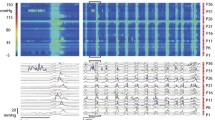Abstract
The purposes of this study were: (1) to quantify human esophageal peristaltic force, (2) to determine the factors which alter this force, and (3) to evaluate the relationship between force and intraluminal pressure. Force was measured in normals by using a mercury-in-Silastic strain gauge. Simultaneous pressures were obtained through constantly infused open-tipped catheters. On separate days a sphere of either 6.0-, 9.0-, or 13.0-mm diameter was attached to the strain gauge and measurements were obtained at three esophageal levels. Studies were done (1) with the subject at rest, (2) while performing a Valsalva maneuver, (3) during the administration of bethanechol, and (4) after intravenous atropine. Peristaltic force increased directly with sphere size but inversely with distance from the lower esophageal sphincter. Intraluminal pressure did not change significantly with sphere size or at different levels of the esophagus. A Valsalva maneuver increased force and pressure significantly only in the distal esophagus. Bethanechol (0.1 mg/kg) had no significant effect on force at any esophageal level, but atropine (0.01 mg/kg) decreased force at each esophageal level and with each sphere size. The distal esophageal response to a Valsalva maneuver was lost following atropine. Intraluminal pressure was a good index of peristaltic force, providing sphere size and esophageal level remained unaltered. These studies suggest that esophageal peristaltic force may be altered by: (1) bolus size, (2) extrinsic maneuvers which alter intraluminal pressure (Valsalva maneuver), and (3) certain pharmacological agents.
Similar content being viewed by others
References
Jacoby HI, Bass P, Bennett DRIn vivo extraluminal contractile force transducer from gastrointestinal muscle. J Appl Physiol 18:658, 1963
Butin JW, Olsen AM, Moersch HJ, Code CF: A study of esophageal pressures in normal persons and patients with cardiospasm. Gastroenterology 23:278, 1953
Code CF, Schlegel JF: The pressure profile of the gastroesophageal sphincter in man: An improved method of detection. Proc Staff Meet Mayo Clin 33:406, 1958
Harris LD, Pope CE II: The pressure inversion point: Its genesis and reliability. Gastroenterology 51:641, 1966
Kelley ML Jr, Wilbur DL III, Schlegel JF, Code CF: Deglutitive responses in the gastroesophageal sphincter of healthy human beings. J Appl Physiol 15:483 1960
Pope CE II, Horton PF: Intraluminal force transducer measurements of human oesophageal peristalsis. Gut 13:464, 1972
Cohen S, Green F: The mechanics of esophageal muscle contraction. Evidence of an inotropic effect of gastrin. J Clin Invest 52:2029, 1973
Cohen S, Green F: Force velocity characteristics of esophageal muscle: Effect of acetylcholine and norepinephrine. Am J Physiol 226:1250, 1974
Sonnenblick E: The mechanics of myocardial contraction. Philadelphia, University of Pennsylvania Press, 1966, p 173
Sonnenblick EH, McCallum ZT: Active state, force velocity relationships and inotropic mechanisms in mammalian heart muscle. Fed Proc 20:126, 1961
Sonnenblick E: Series elastic and contractile element interactions in generation of myocardial force: Effects of changing muscle length, norepinephrine and strophanthidin. Fed Proc 23:118, 1964
Sonnenblick EH: Force-velocity relations in mammalian heart muscle. Am J Physiol 202:931 1962
Sonnenblick EH: Implications of muscle mechanics in the heart. Fed Proc 21:975, 1962
Gordon AR, Siegman MJ: Mechanical properties of smooth muscle. I. Length-tension and force-velocity relations. Am J Physiol 221:1243, 1971
Siegman MJ, Gordon AR: Potentiation of contraction: Effects of calcium and caffeine on active state. Am J Physiol 222:1587, 1972
Parrish D, Strandness DE Jr Bell JW: Dynamic response characteristics of a mercury in Silastic strain gauge. J Appl Physiol 19:363, 1964
Hollis JF, Castell DO: Amplitude of esophageal peristalsis as determined by rapid infusion. Gastroenterology 63:417, 1972
Pope CE: Effect of infusion on force of closure measurements in the human esophagus. Gastroenterology 58:616, 1970
Bancroft H: Introduction to biostatistics. New York, Harper and Row, 1963
Goss CM: The esophagus. Gray's Anatomy. Philadelphia, Lea and Febiger, 1966, p 1206
Burnstock G: Purinergic nerves. Pharmacol Rev 24:509, 1972
Weisbrodt N, Christensen J: Gradients of contractions in the opossum esophagus. Gastroenterology 62:1159, 1972
Author information
Authors and Affiliations
Rights and permissions
About this article
Cite this article
Schoen, H.J., Morris, D.W. & Cohen, S. Esophageal peristaltic force in man. Digest Dis Sci 22, 589–597 (1977). https://doi.org/10.1007/BF01073076
Issue Date:
DOI: https://doi.org/10.1007/BF01073076




